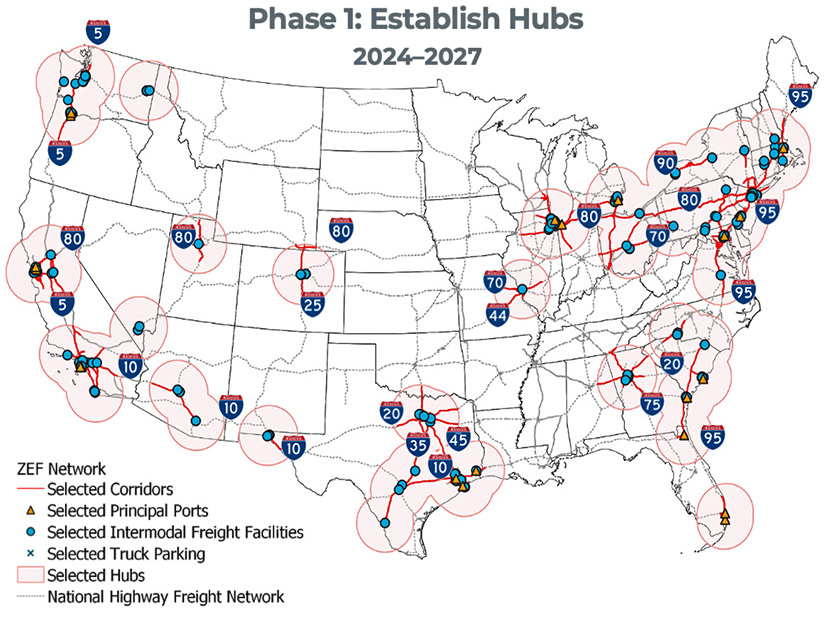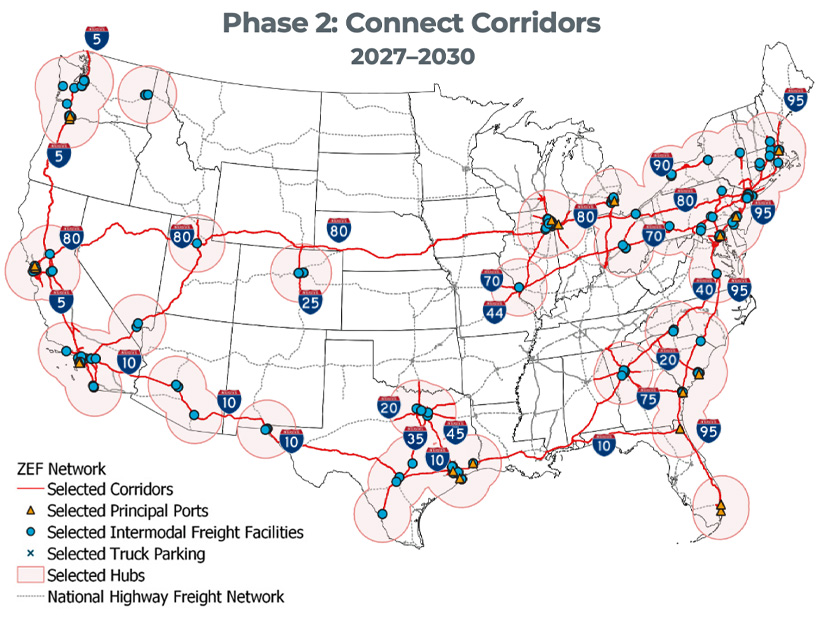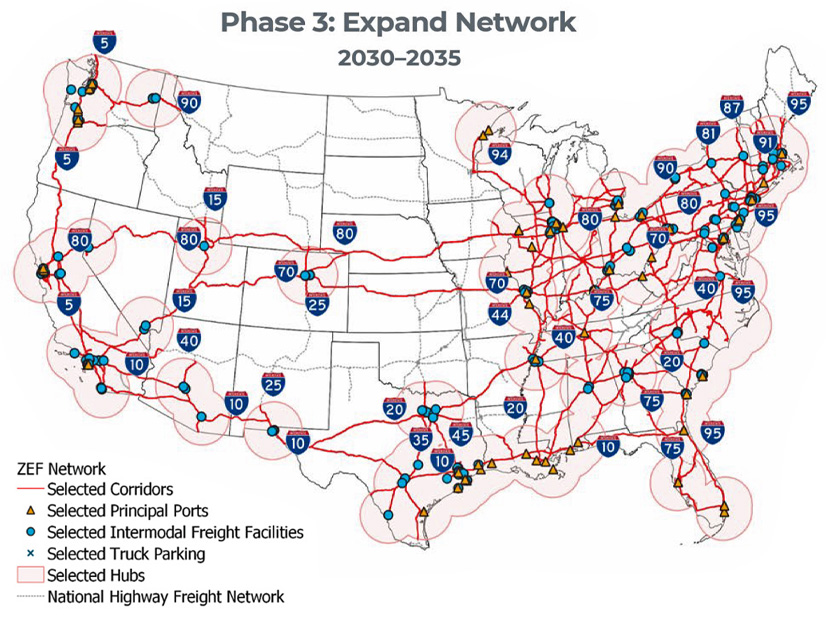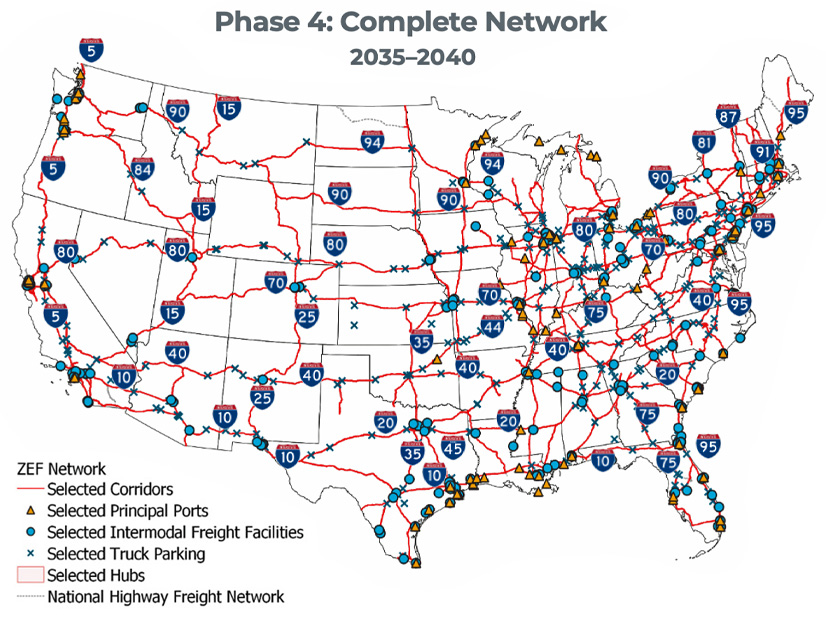
A newly published federal strategy aims to speed up development of a national network of electric charging and hydrogen filling facilities for freight trucks.
The Joint Office of Energy and Transportation said March 12 that the framework offers a way to align government, industry and utility actions on policy and investment decisions along designated freight corridors from coast to coast and eventually in Alaska and Hawaii.
The idea is to meet the trucking industry and zero-emissions technology where they are now, determine how and where they are likely to evolve, then prioritize and sequence infrastructure investment accordingly.
The first phase of the National Zero-Emission Freight Corridor Strategy establishes priority zones called hubs with a radius of 100 to 150 miles that have the conditions to support freight decarbonization. Those conditions include annual freight volume, projected number of zero-emissions medium- and heavy-duty vehicles (MHDVs), high concentration of MHDV-related air pollutants and state policies conducive to zero-emissions vehicle adoption.
Initial efforts will focus heavily on local transportation returning daily to the same base. Regional and long-haul transportation is a longer-term proposition, enabled as the number of hubs and the number of corridors between them grows and there are enough recharge sites to confidently plan interregional movement.
The next three phases are:
-
- connect hubs along critical freight corridors (2027-2030).
- expand corridor connections by developing networks (2030-2035).
- link regional corridors to form a national network with ubiquitous access to charging and refueling (2035-2040).
The Federal Highway Administration will develop National EV Freight Corridors in alignment with the new strategy.
Goals
The United States has committed to a goal of 30% sales of zero-emissions MHDVs by 2030 and 100% by 2040.
That will be impossible to accomplish without radical expansion of the infrastructure to charge or fuel those vehicles and a radical expansion of the infrastructure to support those chargers and pumps.
Federal officials said the March 12 announcement is the cohesive strategy by which that can happen.
MHDVs account for 23% of greenhouse gas emissions in the U.S. transportation sector, the officials said, and they do so to the detriment of specific communities, as 75% of U.S. heavy truck traffic is logged on just 4% of U.S. roads.
“For over a century, petroleum-fueled freight has transported vital food and resources to American families but at the same time, these vehicles have also contributed to lower public health, especially in densely populated communities,” U.S. Secretary of Energy Jennifer Granholm said in a news release announcing the “landmark” strategy intended to change that.
“Communities around the country will benefit from zero-emission freight decarbonizing transportation while continuing to support a vibrant economy,” Gabe Klein, executive director of the Joint Office of Energy and Transportation, said in another news release.
There are some hurdles:
-
- A massive buildout in generation, transmission and distribution must occur because the power grid cannot support heavy-duty EV charging — a single highway charging depot might have a peak demand of up to 40 MW. (See DOE Funds Studies of Heavy-duty EV Charging Network Needs.)
- Technology to generate hydrogen at an economical cost and acceptable environmental impact needs to be developed and scaled.
- All this infrastructure needs to be paid for.
- Electric and hydrogen propulsion technologies for heavy vehicles need to be refined.
- Some states are indifferent or hostile to transportation decarbonization goals — fewer than half have embraced the Advanced Clean Trucks rule.
A key intended function of the strategy announced March 12 is to foster collaboration across sectors — truck fleet operators, zero-emission fuel providers, grid and pipeline operators, energy and environmental regulators, communities — toward creating infrastructure that serves as a national network.
That, in turn, is expected to send clear market signals to support the investments needed to bring it all about.
CALSTART, a nonprofit supporting clean high-tech transportation, welcomed the announcement. The strategy “sets a clear pathway for accelerating the adoption of zero-emission medium and heavy-duty vehicles, which is in line with stringent Phase 3 vehicle standards,” said Trisha Dello Iacono, head of policy at CALSTART. “We commend and support the federal government for embracing a phased-in approach, which will not only expedite deployment but also optimize infrastructure investment, foster collaboration, and drive innovation and job creation in the transportation and freight sectors.”
CALSTART framed the announcement as important for chargers but made no reference to hydrogen, which has uncertain prospects and uneven support despite the Biden administration’s efforts to advance it.
The strategy is a living document: The Joint Office expects to revise it at least annually.




